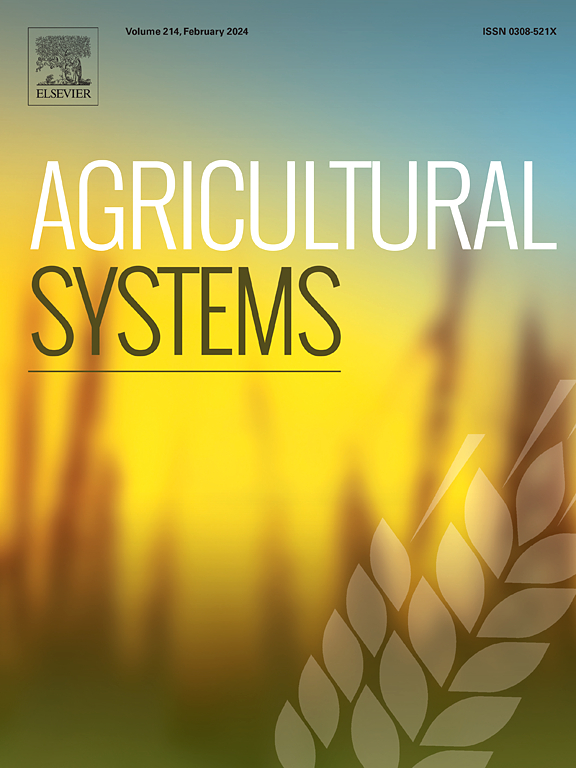Optimization for crop-livestock systems through a holistic watershed based on water quality requirement: a case study in China
IF 6.1
1区 农林科学
Q1 AGRICULTURE, MULTIDISCIPLINARY
引用次数: 0
Abstract
CONTEXT
Agricultural nonpoint source (ANPS) pollution resulted from crop-livestock production is a major contributor to the degradation of surface water quality. Previous studies have proved that optimization of crop-livestock production is an effective way to control ANPS pollution, however, the optimization method through a holistic watershed is lacking.
OBJECTIVE
Here, a novel optimization framework integrating zonal management, dynamic water quality thresholds, and policy-technology synergy was proposed to reconcile agricultural production and environmental goals.
METHODS
The Baiyangdian Watershed (China) was selected as a case study to quantify the water environmental impact of nitrogen (N) and phosphorous (P) from crop-livestock systems (2015–2020). Eight optimization scenarios were simulated to assess potential mitigation strategies.
RESULTS AND CONCLUSIONS
Results from the present study showed that the crop-livestock system contributed to 74.5 % and 89.9 % of N and P fluxes, respectively. Livestock production accounted for 86.2 % and 96.8 % of N and P fluxes from this system. The optimal management strategy was to adjust the crop and livestock structure, achieving 100 % compliance with dynamic water quality targets while ensuring inter-regional equity. Livestock management was essential for enhancing water quality, with integrated strategies demonstrating a 35.3 % exceedance of the requirements of loose thresholds. The impact of livestock reduction on watershed water quality improvement was primarily attributed to the upstream regions, while Baiyangdian's adjacent areas demonstrated exceptional manure management performance due to policy-driven interventions. The achievement of watershed water quality objectives required comprehensive consideration of regional environmental background, with spatial coordinated optimization ensuring holistic compliance.
SIGNIFICANCE
This study not only provided a typical case for coordinated governance at the watershed scale, but also, through the transfer and expansion of scales, offered significant references for water quality management practices at the national and even global scales.

基于水质要求的整体流域作物-牲畜系统优化:以中国为例
农业非点源污染是造成地表水水质退化的主要原因之一。已有研究证明,优化农牧业生产是控制ANPS污染的有效途径,但缺乏整体流域的优化方法。目的提出一种集分区管理、动态水质阈值和政策-技术协同为一体的优化框架,以协调农业生产和环境目标。方法以白洋淀流域为研究对象,定量分析2015-2020年流域农牧业系统氮、磷对水环境的影响。模拟了8种优化方案,以评估可能的缓解策略。结果与结论研究结果表明,农牧业系统分别贡献了74.5%和89.9%的氮、磷通量。畜牧业生产分别占该系统氮磷通量的86.2%和96.8%。最优的管理策略是调整作物和牲畜结构,在保证区域间公平的同时,100%符合动态水质指标。牲畜管理对提高水质至关重要,综合战略表明,较宽松阈值的要求超出了35.3%。畜牧业减少对流域水质改善的影响主要集中在上游地区,而白洋淀邻近地区由于政策驱动的干预措施而表现出优异的粪便管理绩效。流域水质目标的实现需要综合考虑区域环境背景,空间协调优化确保整体合规。本研究不仅为流域尺度上的协调治理提供了典型案例,而且通过尺度的转移和扩展,为国家乃至全球尺度上的水质管理实践提供了重要参考。
本文章由计算机程序翻译,如有差异,请以英文原文为准。
求助全文
约1分钟内获得全文
求助全文
来源期刊

Agricultural Systems
农林科学-农业综合
CiteScore
13.30
自引率
7.60%
发文量
174
审稿时长
30 days
期刊介绍:
Agricultural Systems is an international journal that deals with interactions - among the components of agricultural systems, among hierarchical levels of agricultural systems, between agricultural and other land use systems, and between agricultural systems and their natural, social and economic environments.
The scope includes the development and application of systems analysis methodologies in the following areas:
Systems approaches in the sustainable intensification of agriculture; pathways for sustainable intensification; crop-livestock integration; farm-level resource allocation; quantification of benefits and trade-offs at farm to landscape levels; integrative, participatory and dynamic modelling approaches for qualitative and quantitative assessments of agricultural systems and decision making;
The interactions between agricultural and non-agricultural landscapes; the multiple services of agricultural systems; food security and the environment;
Global change and adaptation science; transformational adaptations as driven by changes in climate, policy, values and attitudes influencing the design of farming systems;
Development and application of farming systems design tools and methods for impact, scenario and case study analysis; managing the complexities of dynamic agricultural systems; innovation systems and multi stakeholder arrangements that support or promote change and (or) inform policy decisions.
 求助内容:
求助内容: 应助结果提醒方式:
应助结果提醒方式:


